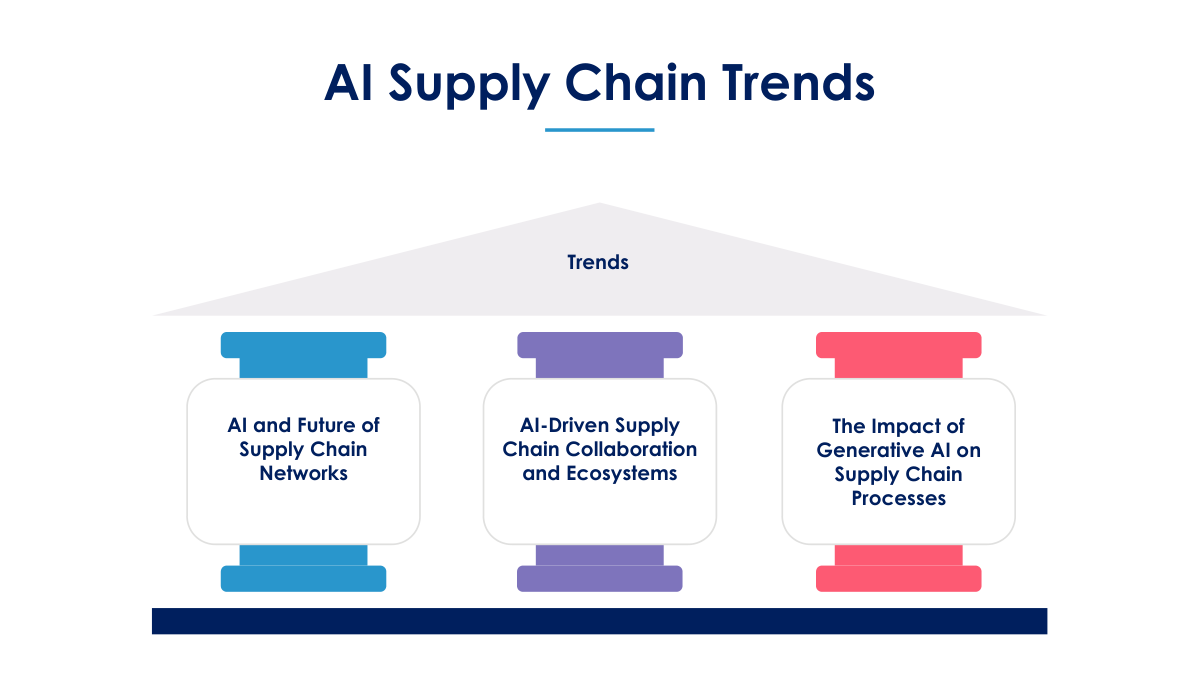Revolutionizing Supply Chains with AI Trends

|
|||||||||||||||||||
|
Here is a detailed article on: AI-Driven Supply Chain Collaboration and Ecosystem: How It Works and Why It MattersIn today’s global, fast-moving economy, supply chains are no longer isolated operations. They are dynamic ecosystems of suppliers, manufacturers, distributors, logistics partners, retailers, and customers. In such a complex environment, collaboration is no longer optional—it is essential. Enter AI-driven supply chain collaboration: an intelligent, connected approach where artificial intelligence enables real-time data sharing, coordination, decision-making, and trust across the entire ecosystem. What Is AI-Driven Supply Chain Collaboration?AI-driven supply chain collaboration refers to the use of artificial intelligence technologies to enhance coordination, communication, and responsiveness between multiple stakeholders in a supply chain. These stakeholders can include:
With AI, supply chain players can move from reactive, siloed operations to predictive, proactive, and collaborative systems. Key Components of the AI-Driven Supply Chain Ecosystem1. Real-Time Data SharingAI platforms ingest data from multiple sources—ERP, IoT devices, partner systems, and market signals—and share filtered, enriched insights across the ecosystem. ✅ Example: A supplier can see downstream inventory levels at the distributor or retailer level and proactively ship goods before stockouts occur. 2. Multi-Party Decision IntelligenceAI agents simulate decisions using input from all stakeholders and recommend actions that optimize for the entire supply chain, not just one node. ✅ Example: Instead of maximizing a factory’s output alone, AI considers warehouse space, shipping costs, and end-demand to suggest optimal production volumes. 3. Autonomous Agents and Task OrchestrationAI agents act on behalf of participants to negotiate, schedule, book freight, or trigger replenishment automatically—while respecting constraints and goals of all parties. ✅ Example: An AI agent can autonomously rebook shipments with a new logistics provider if a partner misses a delivery SLA. 4. Collaborative Forecasting and PlanningAI enables shared demand forecasts, inventory planning, and capacity alignment across organizations using machine learning models. ✅ Example: A consumer goods manufacturer and its retail partners co-create forecasts using shared sales data, resulting in better fill rates and lower overstocks. 5. Trust and Visibility via Blockchain + AIWhen combined with blockchain, AI ensures data integrity, traceability, and trust in transactions between parties (e.g., quality assurance, payments, CO2 tracking). ✅ Example: A food supplier can provide proof of origin, freshness, and temperature data verified by AI + blockchain for retailers. Benefits of AI-Driven Supply Chain Collaboration| Benefit | AI Impact | | --------------------------- | --------------------------------------------------------------------- | | Increased Forecast Accuracy | AI learns from cross-party data to improve demand and supply matching | | Reduced Inventory Cost | Shared planning avoids overstocking and redundant safety stock | | Faster Response Time | Agents can autonomously react to disruptions across the ecosystem | | Improved Partner Trust | AI + secure data sharing creates transparency and accountability | | More Sustainable Operations | Coordinated planning reduces excess transport, waste, and emissions | How It Works: A Flow ExampleScenario: A global electronics brand partners with contract manufacturers, logistics providers, and retail chains.
Enabling Technologies
Industries Benefiting from AI-Driven Collaboration| Industry | Use Case | | --------------- | ---------------------------------------------------------------------------- | | Retail | Co-forecasting promotions with suppliers and logistics partners | | Manufacturing | Just-in-time raw material alignment across global vendors | | Healthcare | Coordinating medical equipment delivery to hospitals based on real-time need | | Food & Beverage | Farm-to-shelf visibility for traceability and freshness | | Electronics | Managing multi-tier suppliers and contract manufacturers efficiently | Conclusion: From Supply Chain to Value NetworkAI-driven collaboration transforms a linear supply chain into a responsive, adaptive network. Businesses can finally break down silos, create shared value, and respond to the dynamic needs of today’s market with intelligence and agility. Organizations that embrace this collaborative AI model will gain a competitive edge—not just in cost savings but in speed, resilience, innovation, and sustainability. |
|||||||||||||||||||
|
Here is a detailed article titled: “The Impact of Generative AI and Agentic AI on Supply Chain Transformation” The Impact of Generative AI and Agentic AI on Supply Chain TransformationThe global supply chain is evolving rapidly, and the twin forces of Generative AI and Agentic AI are catalyzing a new wave of innovation. These technologies are not merely tools for efficiency—they are fundamentally redefining how supply chains think, adapt, and act. This article explores how Generative AI (GenAI) and Agentic AI are transforming key components of the supply chain: planning, operations, risk management, logistics, product development, and customer service. What Are Generative AI and Agentic AI?
Together, these two capabilities allow for cognitive supply chains that can learn, simulate, reason, act, and adapt in real time. 1. Generative AI Use Cases in the Supply ChainA. Demand Planning & Forecasting
B. Supplier Collaboration & Documentation
C. Inventory & Order Optimization
2. Agentic AI Use Cases in the Supply ChainA. Autonomous Procurement Agents
B. Logistics Coordination
C. Warehouse Automation
D. Customer Service Agents
3. Strategic Transformation Enabled by GenAI + Agentic AIA. Cognitive Supply Chain Control TowerAI agents equipped with generative capabilities can observe end-to-end operations, summarize issues, simulate future risks, and recommend mitigation—like a 24/7 autonomous COO. B. Personalized Supply ChainJust like e-commerce personalization, AI agents can dynamically tailor supply chain flows to specific store formats, geographies, or customer types. C. Resilience Through Simulation + AutonomyAI can simulate disruption scenarios (e.g., a port strike or geopolitical conflict) and agents can autonomously reroute supply, identify alternate vendors, and re-prioritize deliveries. D. Data DemocratizationGenerative AI turns complex datasets into natural language dashboards, allowing non-technical users (planners, vendors, store managers) to interact with supply chain data more intuitively. Real-World Example: A Transformed Electronics Supply Chain
Conclusion: From Automation to AutonomyThe integration of Generative AI and Agentic AI into supply chains shifts the paradigm from automating isolated tasks to enabling intelligent, adaptive, and self-correcting systems. These technologies turn supply chains into living, learning ecosystems that are proactive, efficient, and resilient. Companies that invest early in these AI capabilities will gain a critical edge—faster response times, optimized operations, enhanced collaboration, and smarter decisions at every level. |
|||||||||||||||||||